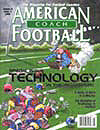AMERICAN FOOTBALL MONTHLY THE #1 RESOURCE FOR FOOTBALL COACHES
Article CategoriesAFM Magazine
|
High Schools That Went High Techby: Jamie DeMoney© More from this issue When Rob Scheidt took over the program at Merced (Calif.) H.S. in the spring of 1996, he faced a rebuilding job. The historically strong MHS program, which won a state championship just five years before, had spiraled downward into a two-year playoff draught and was stinging from a 1-9 record the previous season. Scheidt, who became head varsity coach at Merced while he was still in his mid-20s, saw a couple of problems that needed to be addressed right off the bat. First, the school was suffering the affects of a district split a few years before, which reduced his numbers. Secondly, he wanted the program to run more efficiently and give his coaching staff more time coaching and less time doing busy work. The solution, as he saw it, was to invest in better technology in the film room. "We wanted to use film to better t....The full article can only be seen by subscribers.
|
|
|||||||
| HOME |
MAGAZINE |
SUBSCRIBE | ONLINE COLUMNISTS | COACHING VIDEOS |
Copyright 2025, AmericanFootballMonthly.com
All Rights Reserved





